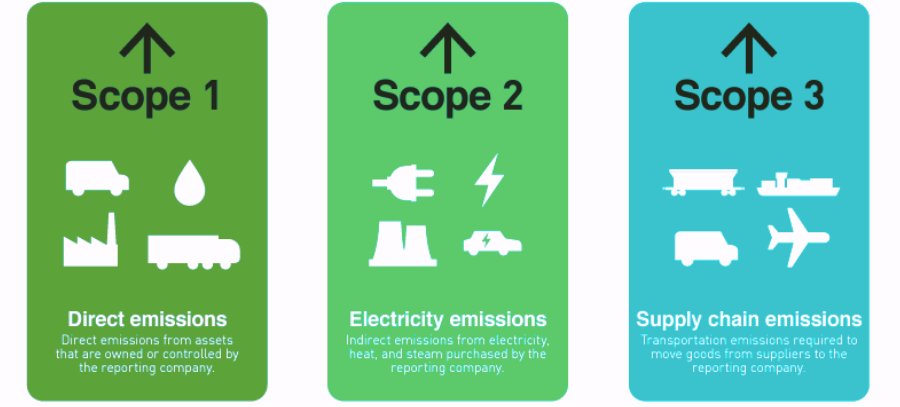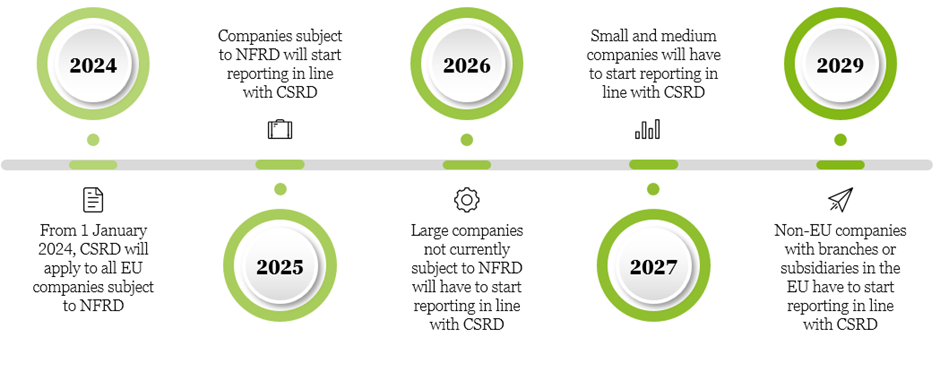CSRD in logistics:
a comprehensive guide!
Although CSRD is a European directive, it can also apply to many non-EU companies. This article addresses the following:
✔ What are the key aspects and implications of CSRD?
✔ How to be prepared for the CSRD requirements?
✔ CSRD at a glance: who, when, what and how?
What is the CSRD?
The Corporate Sustainability Reporting Directive (CSRD) in the logistics industry is a regulatory framework to ensure that logistics companies transparently report their sustainability efforts and environmental impacts.
This directive compels logistics firms to provide detailed information on their sustainability practices, contributing to greater accountability and fostering environmentally responsible practices within the sector. It is a European Union legislation initiative to advance sustainability reporting practices among companies.
The CSRD builds upon the existing Non-Financial Reporting Directive (NFRD) and aims to broaden the scope and enhance the quality of sustainability reporting. It expands the scope of reporting beyond financial information to encompass environmental, social, and governance (ESG) factors. This includes detailed reporting on greenhouse gas emissions and other environmental impacts.
The CSRD establishes a standardized reporting framework, ensuring consistency and comparability of sustainability data across companies.
What are the key aspects of the CSRD?
Expanded Scope
The CSRD extends reporting obligations beyond just large listed companies to include a wider range of entities, including certain small and medium-sized enterprises (SMEs).
Detailed Reporting Requirements
The directive requires companies to disclose more comprehensive information on their environmental, social, and governance (ESG) performance. This includes reporting on topics such as greenhouse gas emissions, energy consumption, and resource usage.
Standardized Reporting
The CSRD aims to standardize reporting by introducing mandatory sustainability reporting standards, ensuring consistency and comparability of data across organizations.
Digital Reporting
The directive promotes the use of digital reporting methods to facilitate accessibility, analysis, and comparability of sustainability information.
What are the implications of CSRD?
The logistics industry, responsible for the movement of goods and services, plays a significant role in CO2 reporting, which involves measuring, quantifying, and disclosing carbon emissions produced by logistics activities. This reporting is essential for tracking progress toward emission reduction goals and enabling companies to make informed decisions about sustainability strategies.
Where to start with the CSRD requirements?
Here's a general outline of how to approach CO2 reporting in the logistics sector:
Data Collection
Gather data on fuel consumption, distance traveled, mode of transport, and other relevant factors from various sources within your logistics operations. There should be equal focus on data quality and integrity, ensuring that the collected data is actionable and aligns will the overall CSRD goals for your company. The data can be collected from your sub-contractors or carriers by a potential SFTP server or EDI connection. One major challenge would be the diversity of data sources, as companies often operate in different industries and regions, each with unique reporting standards and practices. Standardizing and consolidating this data into a coherent format for CSRD compliance can be complex.
Emission Calculation
Once sufficient data is available, the CO2 calculation can be done. However, it must be kept in mind that the calculation can be very dependent on many factors and constants used like the fuel efficiency factor of the type of fuel or the CO2 emission factor of the mode used for your transport. Use emission factors provided by relevant authorities or industry standards to calculate CO2 emissions for each activity.
Scope Classification
Classify emissions into three scopes: Scope 1 (direct emissions from owned or controlled sources), Scope 2 (indirect emissions from purchased energy), and Scope 3 (other indirect emissions, including supply chain emissions).
 Source: Smart Freight Centre (2023). Global Logistics Emissions Council Framework for Logistics Emissions Accounting and Reporting.
Source: Smart Freight Centre (2023). Global Logistics Emissions Council Framework for Logistics Emissions Accounting and Reporting.
Scope 1 Reporting: This pertains to direct emissions that a logistics company generates from its own operations. It includes emissions from owned or controlled sources like company vehicles and facilities. Logistics might involve tracking fuel consumption, energy usage, and on-site activities contributing to greenhouse gas emissions.
Scope 2 Reporting: This involves indirect emissions resulting from the generation of purchased energy. In the logistics sector, this mainly concerns the electricity consumed by the company. This could be in warehouses, offices, and other facilities. Companies can aim to reduce Scope 2 emissions via many strategies; a common one is transitioning to renewable energy sources.
Scope 3 Reporting: This is the broadest scope, encompassing all other indirect emissions in a company's value chain. For logistics, this includes emissions from transportation, distribution, and other activities that occur outside of the company's direct control. This could involve emissions from third-party transportation providers, suppliers, and even the end-use of products or services.
Reporting Tools
Utilize specialized CO2 reporting tools or software that help automate data collection, emission calculations, and report generation. As mentioned earlier, the different types of data collected from different carriers on different levels of data completeness can be a hindrance to the reporting side as well. Ensuring the accuracy and completeness of sustainability metrics from various entities is crucial for credible reporting. Data privacy and security concerns also arise, requiring robust measures to protect sensitive information. Timely data submission and effective communication with reporting entities further complicate the complexity. Achieving compliance with CSRD necessitates careful coordination, stringent data validation, and clear reporting protocols.
To overcome these challenges, establishing clear data collection protocols, leveraging technology for data integration and validation, conducting regular audits, and fostering collaborative relationships with carriers are essential steps. A dedicated carrier management team combined with the right reporting tools can help with being in control over this. Additionally, having a dedicated sustainability reporting team or partnering with a 4PL service provider can help navigate these reporting challenges effectively.
Verification
Reported information will need to be audited, which will be done by accounting firms. Consider third-party verification to enhance the credibility of your CO2 reporting. Verification ensures the data and calculations are accurate and aligned with established standards. A standard sustainability reporting verification process is expected to follow for CSRD compliance:
External Assurance Providers: Companies often engage external assurance providers, which are independent auditing or accounting firms, to review and validate their sustainability reports. These firms have expertise in evaluating environmental data and ensuring compliance with reporting standards.
Standardized Frameworks: Companies structure their sustainability reporting using standardized reporting frameworks like the COFRET or GLEC frameworks or other regional or industry-specific standards. These frameworks provide guidelines for data collection, calculation methodologies, and reporting formats, making it easier for auditors to assess the accuracy of the reported information.
Data Collection and Documentation: Companies are required to maintain thorough records of their emissions data, including methodologies used for calculation, data sources, and any assumptions made. This documentation is subject to review by external auditors.
Independent Audits and Reviews: Assurance providers conduct independent audits or reviews of the reported data. This involves examining the company's processes for data collection, verification, and reporting to ensure they align with established standards and methodologies.
Sampling and Testing: In some cases, assurance providers may conduct sampling or testing to validate reported data. For example, they may verify fuel consumption records, inspect energy-efficient technologies, or conduct on-site inspections to confirm the accuracy of reported emissions.
Stakeholder Engagement: External assurance may also involve stakeholder engagement, including employees, suppliers, customers, and regulatory bodies. This helps ensure that the reported data reflects a comprehensive and accurate representation of the company's environmental performance.
Reporting of Assurance Findings: The assurance provider issues a report summarizing their findings. This report outlines whether the reported data is accurate, reliable, and compliant with the chosen reporting framework. It may also highlight any areas for improvement or concerns.
Disclosure of Assurance Statement: The company includes the assurance provider's statement in their CSRD report. This statement indicates that the reported data has undergone an independent review and provides confidence in its accuracy.
Setting Targets
Based on reported emissions, realistic and measurable targets to reduce carbon emissions should be set. Implement strategies such as adopting greener transportation modes, optimizing routes, and investing in energy-efficient technologies. The targets should be in line with legislation, on a member state level or EU level, like the Green Deal target for 2030.
Transparency and sharing data with customers/carriers
Disclose CO2 emissions data in your sustainability reports, aligning with the CSRD's reporting requirements. Transparent reporting demonstrates your commitment to sustainability and can attract environmentally conscious clients and investors. The ISO 14083 standard should help in gaining some level of certainty on following the same principles in data measuring, calculating, allocating & sharing.
LEAVE YOUR CONTACT DETAILS AND WE WILL CONTACT YOU.
Want to know more about CSRD reporting?
Ask about CSRD, other SmartWay Logistics services, pricing, implementation or any other concerns.
Our experts are ready to answer your questions. You can also download our leaflet or call us (+31(0)30 - 82 00 800).

When does the CSRD come into effect?

Will companies be penalized for non-compliance with CSRD?
It is still uncertain when the EU Commission will start penalizing businesses for failing to comply with CSRD, but these penalties are expected to be significant. The nature and value of the penalties will depend on different Member States.
CSRD wrap-up: 6 things you want to know!
Under the CSRD, it's imperative to handle your ESG data with the same level of diligence as your financial data. This entails incorporating sustainability metrics alongside financial figures in the annual report. The ramifications of this shift are extensive:
- >The volume of data to be gathered will experience a significant surge.
-> Likewise, there will be a notable increase in the personnel engaged in the integrated reporting process.
-> Stakeholders will approach ESG information with a similar level of scrutiny as they do financial data.
-> Reports will be required to be in a digital format.
-> Sustainability data will need to undergo auditing.
-> This transformation will prompt organizations to reevaluate long-standing reporting procedures.
If your company is obligated to adhere to the CSRD, it is essential to take proactive measures. Initiate the preparation process promptly, as the compliance deadline is rapidly approaching. Consider seeking expert guidance to effectively navigate the stipulations and ascertain which data needs to be gathered and when it should be disclosed.
It can be challenging to stay on top of the requirements and determine the specific data to collect and disclose. We are ready to guide you through this process if necessary, ensuring your company is fully prepared for the CSRD. Reach out to us for assistance.
